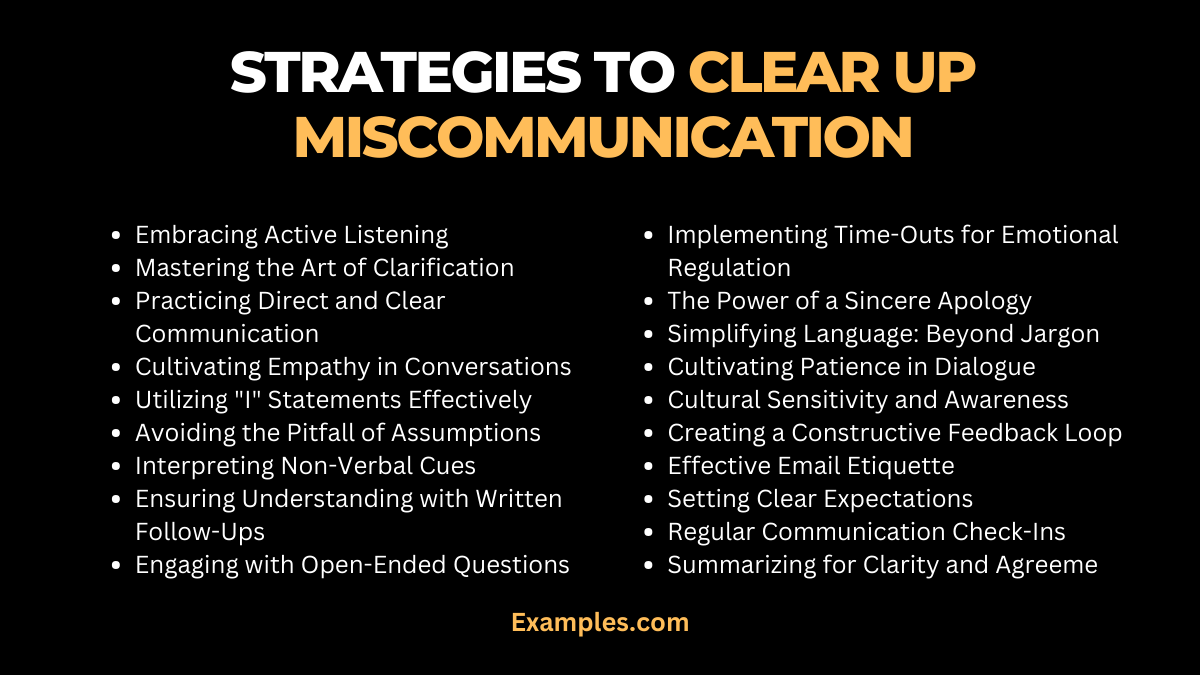How to Fix/ Clear up Miscommunication – 9+ Examples, How to clear
Miscommunication can lead to unnecessary conflicts and misunderstandings. This comprehensive guide, peppered with practical miscommunication examples, aims to equip you with the tools to effectively resolve and prevent such situations. Whether it’s in personal relationships, the workplace, or casual interactions, understanding the nuances of communication is key. Let’s explore strategies to clear up miscommunication and foster clearer, more effective exchanges.
Strategies to Clear up Miscommunication

- Active Listening: Focus on what the other person is saying, without interrupting.
Example: In a team meeting, if there’s confusion about a project, listen to each team member’s perspective before responding. - Clarify and Confirm: Ask questions to ensure understanding.
Example: Repeat back what you heard in your own words to avoid any misinterpretation. - Use “I” Statements: Express your feelings without blaming.
Example: Say “I feel confused about this part,” instead of “You’re not making sense.” - Non-Verbal Cues: Pay attention to body language and tone.
Example: A partner’s crossed arms might indicate they’re upset, even if they say they’re fine. - Direct Communication: Be clear and concise.
Example: Instead of vague instructions, provide specific steps and deadlines. - Empathy: Try to understand the other person’s perspective.
Example: If a colleague missed a deadline, consider their workload before reacting. - Avoid Assumptions: Don’t jump to conclusions.
Example: If a friend hasn’t replied to a message, don’t assume they’re ignoring you. - Be Open to Feedback: Accept constructive criticism.
Example: If someone points out a flaw in your plan, consider their advice. - Written Clarification: In complex situations, follow up with an email.
Example: After a discussion, send a summary to all parties involved. - Apologize When Necessary: If you’ve contributed to the miscommunication, own up.
Example: Admitting a mistake can defuse tension and lead to a solution.
How do you fix miscommunication in a relationship?
- Open Dialogue: Schedule regular check-ins with your partner.
Example: A weekly ‘how are we doing’ conversation can prevent many issues. - Respectful Listening: Pay attention without planning your response.
Example: When your partner is upset, listen fully before offering solutions. - Honesty: Be truthful about your feelings and thoughts.
Example: Sharing your fears and insecurities can strengthen trust. - Quality Time Together: Invest in shared activities.
Example: A regular date night can improve communication and intimacy. - Compassionate Understanding: Show empathy towards your partner’s experiences.
Example: Recognizing their stress at work can explain their short temper. - Conflict Resolution Skills: Learn to navigate disagreements healthily.
Example: Use ‘time-outs’ when arguments get too heated, to cool down. - Avoid Blame Game: Focus on the issue, not the person.
Example: Discuss solutions instead of pointing fingers during arguments. - Seek Professional Help: Consider couples counseling.
Example: A therapist can provide unbiased guidance and tools for better communication. - Personal Space: Respect each other’s need for alone time.
Example: Giving your partner space after a long day can prevent misunderstandings. - Love Languages: Understand how your partner expresses and receives love.
Example: If your partner values acts of service, helping out around the house can be a form of communication.
How to fix clear up miscommunication in the workplace
- Regular Meetings: Hold team meetings to ensure everyone is on the same page.
Example: Weekly catch-ups can clarify roles and responsibilities. - Clear Instructions: Provide detailed guidance on tasks.
Example: Use bullet points in emails to outline specific actions needed. - Feedback Culture: Encourage open feedback among colleagues.
Example: A suggestion box can be a way for employees to voice concerns anonymously. - Respect Differences: Acknowledge diverse communication styles.
Example: Some may prefer direct communication, while others need more context. - Professional Development: Offer training in communication skills.
Example: Workshops on effective emailing can reduce misunderstandings. - Conflict Resolution Policy: Have clear procedures for addressing disputes.
Example: A step-by-step process ensures fair handling of conflicts. - Inclusive Decision Making: Involve team members in decisions.
Example: Brainstorming sessions allow everyone to contribute ideas. - Email Etiquette: Encourage concise, clear emails.
Example: Avoid jargon and lengthy paragraphs to prevent confusion. - Cultural Awareness: Be mindful of cultural differences in communication.
Example: Understanding cultural nuances can avoid misinterpretations. - Technology Use: Leverage tools like Slack or Trello for clearer communication.
Example: Using a shared project management tool can keep everyone updated.
How to clear up a misunderstanding with a friend
- Immediate Address: Don’t let misunderstandings fester.
Example: If you’re upset about a comment, bring it up sooner rather than later. - Personal Approach: Face-to-face conversations are often more effective.
Example: Meeting in person to talk can clear up miscommunications that occurred over text. - No Blame: Focus on how the situation made you feel.
Example: “I felt hurt when…” is better than “You hurt me by…” - Patience: Give your friend time to explain their side.
Example: Allow them to speak without interrupting, to fully understand their perspective. - Shared Experiences: Remind each other of the strength of your friendship.
Example: Recalling good times can put the current issue in perspective. - Seek to Understand: Ask questions to clarify their intentions.
Example: “What did you mean when you said…” can reveal their true meaning. - Stay Calm: Keep your emotions in check during the conversation.
Example: Taking deep breaths can help maintain a calm demeanor. - Forgiveness: Be willing to let go of grudges.
Example: Accepting an apology and moving on can strengthen your friendship. - Reassurance: Reinforce your commitment to the friendship.
Example: Ending the conversation with positive affirmations can rebuild trust. - Reflect and Learn: Use the experience to improve your communication.
Example: Discussing what could be done differently next time prevents future issues.
In a world where miscommunication can easily disrupt personal and professional relationships, this guide provides essential strategies for effective resolution. From active listening to empathy, the key lies in understanding and adapting to various communication styles. Remember, clear communication is the cornerstone of all successful interactions.



